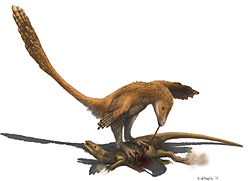Theropoda

Tyrannosaur tooth marks are the most commonly preserved feeding traces of carnivorous dinosaurs. [8] It is usually not possible to identify tooth marks on bone made by small predatory dinosaurs due to similarities in the denticles on their teeth. [8] However, there are exceptions, like an ornithomimid caudal vertebra that has tooth drag marks attributed to Saurornitholestes and a partial Troodon skeleton with preserved puncture marks. [8] Small bones of small theropods that were preyed upon by larger ones may have been swallowed whole and digested frequently enough to affect their abundance in the fossil record. [9]
In 2001, Bruce Rothschild and others published a study examining evidence for stress fractures in theropod dinosaurs and the implications for their behavior. [10] Since stress fractures are caused by repeated trauma they are more likely to be a result of the animal's behavior than fractures obtained during a single injurious event. [11] The distribution of stress fractures also has behavioral significance. [12] Stress fractures to the hand are more likely to result from predatory behavior since injuries to the feet could be obtained while running or migrating. [12] In order to identify stress fractures occurring in the feet of Allosaurus specifically due to predatory behavior, the researchers checked to see if the toes which bore the greatest stress while in motion also had the greatest percentage of stress fractures. [13] Since the lower end of the third metatarsal would contact the ground first while a theropod was running it would have borne the most stress and should be most predisposed to suffer stress fractures. [13] The lack of such a bias in the examined fossils indicates an origin for the stress fractures from a source other than running, like interaction with prey. [13] They suggested that such injuries could occur as a result of the allosaur trying to hold struggling prey with its feet. [13] Contact with struggling prey is also the likely cause of tendon avulsions found in the forelimbs of Allosaurus and Tyrannosaurus . [13] The authors concluded that the presence of stress fractures provide evidence for "very active" predation-based diets rather than obligate scavenging. [10]
Saurornitholestes preyed upon by juvenile tyrannosaur

A. R. Jacobsen published a description of a dentary referred to Saurornitholestes with tooth marks. [14] The dentary is about 12 cm long and preserves fifteen tooth positions; ten of these have teeth, with five of those teeth fully erupted and intact, two broken but functional as evidenced by the presence of wearfacets, and three only partially erupted. [15] Three toothmarks were visible on the lingual surface of the dentary. [15] Two of the three marks are series of grooves made by the serrations on the maker's teeth. [15]
The first consists of 6-7 parallel grooves within a 4 × 1.3 mm area beneath the alveolus of the third tooth and angled at 45° to the dentary's longitudinal axis. [15] The striations are between .37 mm and .40 mm thick with cuboidal cross-sections. [16]

The second tooth mark lies between the fifth and sixth alveoli and consists of two smaller grooves separated 1.8 and 1.6 mm respectively from a larger central groove, with a V-shaped groove beneath it at an angle of 60° to the longitudinal axis of the jaw. [16] The third mark consists of four parallel grooves in a 2 × 2 mm area on the seventh tooth oriented at 90° to the longitudinal axis of the tooth. [16]
The shapes of the preserved serrations are too different from those of Saurornitholestes for the marks to be the result of injuries incurred during intraspecific face biting behaviors. [17] Although the right shape for Dromaeosaurus tooth serrations, the preserved marks are too coarse to have been left by that genus. [17] Although a specific identification cannot be made, the most likely perpetrator would be a juvenile individual of one of the Dinosaur Park Formation's tyrannosaurids, like Gorgosaurus , Daspletosaurus , or Aublysodon . [9] Jacobsen determined that all of the marks on the jawbone were left by the same animal because the serration marks all share the same morphology. [17]

Dromaeosauridae
Saurornitholestes
An ornithomimid caudal vertebra has been discovered that has tooth drag marks attributed to Saurornitholestes. [8]
Deinonychus
Deinonychus , along with other similar dromaeosaurs, were suggested to kill prey in a similar manner to modern accipitrid birds of prey, due to the similarities of their grasping talons. The Deinonychus would pin the prey down with its own weight, restrain it with its hind feet talons, and dismember it with its mouth. [18]
